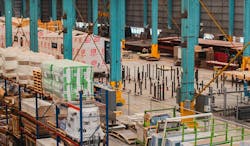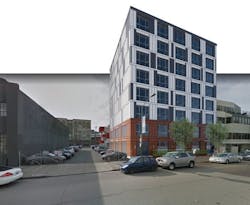Webcor’s new investment arm bets on modular
The modular construction market in North America is projected to expand to nearly $35 billion by 2030, from $21.5 billion in 2023, according to Fortune Business Insights estimates. To get a bigger piece of that growth, the California-based general contractor Webcor recently acquired a 10% stake in R2 Building, a nearly four-year-old modular construction firm headquartered in Oakland, Calif., with a manufacturing plant in General Escobedo, Mexico.
R2 Building’s Type 1 noncombustible steel building system for high-rise construction features prefabricated foundations, unitized stair towers, elevator towers and mechanical shafts. R2 also produces steel-framed Accessory Dwelling Units, and modular single-family homes. R2 recently launched its first multifamily project: 335 Third Street, an eight-story 38-unit apartment building developed by RAD Urban in Oakland’s Jack London district.
“Modular construction has the potential to reshape how we approach large-scale housing projects, from market-rate to affordable and student housing, and even hospitality,” said Jit Pahilajani, Webcor’s Executive Vice President, in a prepared statement.
While Webcor had utilized modular components in the past, the intent of its investment in R2 Building “is to facilitate a partnership in refining volumetric modular approaches with direct input from a general contracting design builder’s perspective,” said Webcor in response to questions from BD+C.
Jay Janda, R2’s Architectural Engineer, whose resume includes stints with RAD Urban and Nautilus Group, is responsible for the design of 335 Third Street. Align Real Estate is sponsoring this project.
Investing in efficiency
Webcor made this investment in R2 Building through its newly formed Webcor Ventures LLC, which it set up to further Webcor’s investment in emerging construction solutions. When asked what Webcor Ventures’ investment criteria are, the company told BD+C “there is no limitation to how investments may be analyzed. Any potential for advancement in construction safety, efficiency, or quality may be considered in the future.” Webcor went on to say that it would inject capital into Webcor Ventures on an “as-needed” basis from retained earnings.
Webcor’s Senior Vice President Todd Mercer will represent his company on R2’s board of directors. Mercer will also act as a conduit to integrate R2’s technology into Webcor’s operations. Webcor also sees this investment as a way to expand career opportunities for its employees.
“Owning a stake in R2 aligns with our goal of differentiating our delivery models and exploring innovative construction solutions,” said Webcor’s President and CEO Matt Rossie.



